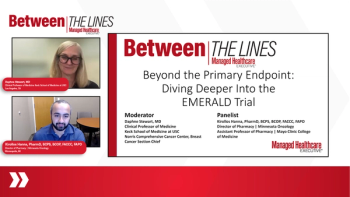
Key Data Analysis from CLEAR Outcomes Trial
Medical experts highlight key findings from the CLEAR Outcomes trial.
Episodes in this series
Leslie Cho, M.D., FACC, FESC, FSCAI: Maybe we can now jump toward the outcome of the trial [CLEAR Outcomes, NCT02993406]. The data was analyzed in the best possible way. This is a randomized, double-blind, placebo-controlled trial, and the highest standard in terms of statistical rigor was the intention to treat. So this was an intention to treat analysis. And that’s super important. That’s the highest level and obviously, even if the patient stopped taking bempedoic acid, we still counted them in that arm if they had events, which is key.
Seth S. Martin, M.D., M.H.S., FACC, FAHA, FASPC: Yeah. I agree. That’s the highest level of evidence. That’s the most rigorous way to conduct trials. And frankly, what we would expect for a cardiovascular trial run by a very experienced and sophisticated team, and by using that intent-to-treat approach, we’re really preserving the benefits of randomization where all the bias is randomized out.
Leslie Cho, M.D., FACC, FESC, FSCAI: Let’s dive into the key primary and secondary outcomes. I’m just going to ask you, what are your thoughts when you saw the 4- point MACE [major adverse cardiovascular events] have clear outcomes?
Seth S. Martin, M.D., M.H.S., FACC, FAHA, FASPC: First of all, this was a positive trial. It was wonderful. The first positive trial powered for MACE had an oral non-statin drug that’s including both primary and secondary prevention patients. And we will talk a little bit about, there was some difference in how much the risk reduction was in magnitude in secondary versus primary prevention. Overall, we saw that the relative reduction was 13%. So the hazard ratio is 0.87, meaning there’s a 13% relative reduction. Now we could get a group of folks together and maybe debate, did you think it was going to be a little bit more or a little bit less? We may get some opinions around that, but the reality is, it is in line with what would be expected based on the amount of LDL [low-density lipoprotein] lowering. This result does line up with the predicted reduction based on cholesterol treatment trial data, which maps the absolute reduction in LDL to the amount of relative reduction, and that’s based on all the statin trials and other major lipid trials. So I think this was in line with that the 4-point MACE. The absolute risk reduction was the difference of 13.3 minus 11.7. So 1.6%, and that translates to a reasonable number needed to treat well below 100. So overall, these are positive results consistent with what we would expect. We see that if we look at 3-point MACE, the hazard ratio is even a little more favorable. And then for fatal and nonfatal MI [myocardial infarction], it’s even more favorable to 23% relative risk reduction.I think that’s what many of us as cardiologists are thinking about this drug in our heart attack population. And so that’s particularly relevant and was nice to see.
Leslie Cho, M.D., FACC, FESC, FSCAI: Yeah. I agree with you. I think this was to be expected. And I’m so glad you brought up the LDL reduction in keeping with the CTT [Cholesterol Treatment Trialists] and that this is what kind of event reduction we would see. So it’s not a surprise that when you have an LDL reduction, you will get MACE reduction. And it’s interesting, they’re completely different drugs in different populations. The relative risk reduction, which is about 13% to 15%, is what you saw in FOURIER [NCT01764633], which is on the PCSK9 trials. And this is obviously much better than the IMPROVE-IT trial [NCT00202878] with the ENHANCE trial, [NCT00552097] which was like 6% relative risk reduction. So the LDL hypothesis remains and is affirmed, again, with CLEAR Outcomes, which is I think a nice finding.
Seth S. Martin, M.D., M.H.S., FACC, FAHA, FASPC: It is a nice finding. I’m glad you made that point because it’s so remarkable how consistent that result has been. That LDL lowering leads to a reduction in atherosclerotic cardiovascular disease events in a time where often science disagrees and sometimes can’t be reproduced. That’s a finding that’s been reproduced again and again and again, with multiple drug classes over the decades. I think that’s something to feel very good about. The other thing I would point out is that in the control arm there was over the course of the trial, the use of extra drugs, such as PCSK9 inhibitors disproportionally in the control arm, which would serve to blunt the effect that we see. So it is possible this effect size is actually an underrepresentation of the true effect size because of the bleeding in the control group.
Leslie Cho, M.D., FACC, FESC, FSCAI: Yeah. You’re absolutely right. The placebo arm did have way more drop in rates at PCSK9 use and other drug use. So you’re absolutely right. It would be much more profound if you had just taken people and treatment-only analysis, but obviously, this is the intention-to-treat analysis. So even in the intention-to-treat analysis, you see this very nice risk reduction. I think the drug works. The drug works by lowering LDL, and the LDL hypothesis is a good hypothesis because throughout the last 40 years it continues to be affirmed.
Transcript edited for clarity.
Newsletter
Get the latest industry news, event updates, and more from Managed healthcare Executive.





















































